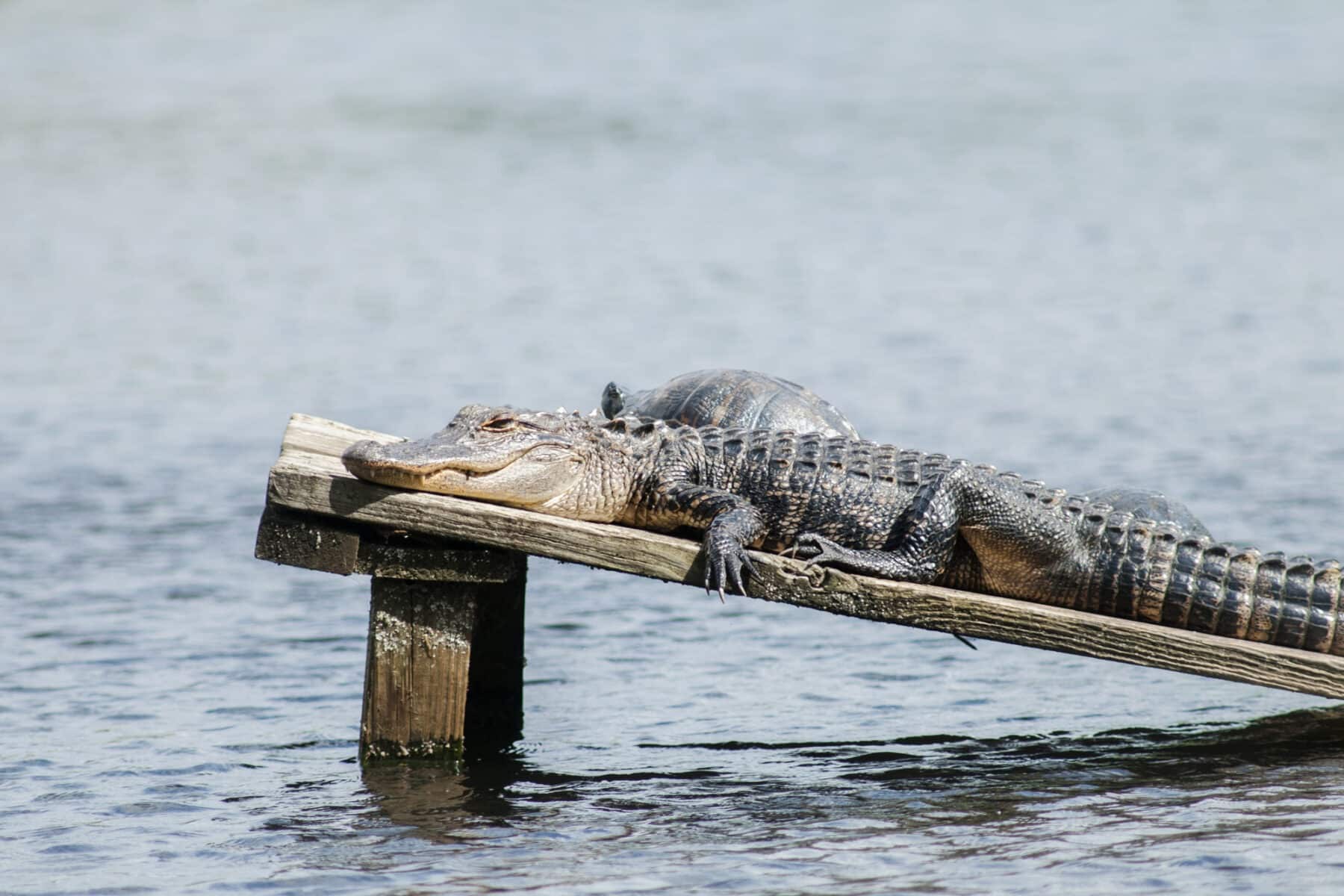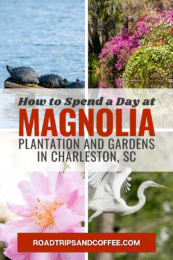Explore Charleston, SC Series
This article is part of the Charleston, South Carolina series. Click the button to read more articles, itineraries, and travel guides in the series.
It is quite difficult to have a bad day at Magnolia Plantation and Gardens. Not that I’ve ever tried to have a bad day, mind you. Sometimes I take a long walk through the romantic-style gardens. Other times, I sit by a lake watching great white egrets fly over alligators lounging in the sun. Yes, it is quite difficult to have a bad day at my favorite plantation in Charleston, South Carolina.
I’ve been to Magnolia Plantation and Gardens about a dozen times now. Out of all the plantations in the Charleston area, this is my favorite to visit. There are so many things to see and do. And even on the busiest of days, there are peaceful nooks and crannies to explore with not another soul in sight.
One of the things I love most about Magnolia Plantation is the variety of activities. You can simply take a walk through the gardens, or you can choose from one of their exciting tours. Just about any direction you decide to walk leads to a footbridge crossing a pond, and wildlife is teeming everywhere.
To help you figure out the options, I’ve put together this handy guide on how to spend an exciting day at Magnolia Plantation and Gardens.
- Address | 3550 Ashley River Road, Charleston, SC 29414
- Phone | 843-571-1266
- Website | www.magnoliaplantation.com

Brief History
In 1676, just a few years after the Charles Town colony was established, Thomas and Ann Drayton arrived on a boat from Barbados and established Magnolia Plantation. For over a century, rice was the primary crop produced on the plantation.
When Thomas Drayton, the great-grandson of the plantation’s founder, died in 1825, he willed the estate to his grandsons, Thomas and John Grimke. But when Thomas Grimke died suddenly from a hunting accident, John Grimke Drayton found himself the owner of a lucrative South Carolina plantation at the age of 22.
In the 1830s, Drayton contracted tuberculosis. He took time off from his work as a minister and stayed at Magnolia Plantation to recover. Decades earlier French botanist Andre Michaux brought the Asian azalea to the United States. While spending time on his plantation Thomas Drayton became the first person to plant the azalea bush in a garden.
When the Civil War effectively ended the plantation economy of the South places like Magnolia Plantation had to find a new source of income. At first, the plantation was strip-mined for valuable phosphates in the soil, but that venture didn’t last long. In 1870 the natural gardens Drayton had so lovingly tended were opened to the public for the first time, making Magnolia Plantation one of the oldest botanical gardens in the country.


Explore the Romantic Style Gardens
According to Magnolia Plantation’s website, they are home to “America’s Last Large-Scale Romantic-Style Gardens.” Although I’m not an expert on “large-scale” gardens, I can personally vouch for the romantic-style gardens.
The paths at Magnolia Plantation are not paved with concrete but instead covered with fine gravels that crunch beneath your feet with each step. The paths crisscross, wind around lakes and ponds, and lead to secret alcoves. Massive oak trees cast a blanket of shade across the shrubs and flower beds where something different is blooming each month.
While winding through the gardens, be sure to visit the most photographed spot at Magnolia Plantation. The White Bridge stretches across a small lake near the plantation house. The bridge is a constant backdrop for selfies and portraits, but walking across it is the most exciting part.
Travel Tip | All visitors enter the gardens through the ticket booths. After you pay for admission and pick up a map, cross the road toward the restrooms. Turn right and walk between two administration buildings. You’ll come to a small pond with a view of the gorgeous red footbridge. Welcome to Magnolia Plantation!

Tour the Plantation House
The Main House at Magnolia Plantation isn’t exactly a traditional southern plantation, and it’s not the original plantation house. It was built in nearby Summerville just before the Revolutionary War and moved to its current location shortly after the Civil War.
45-minute guided tours of the house explore the history of the Draytons and Magnolia Plantation. The tour covers most of the beautifully decorated home, which appears much as it would have during the 1800s. The coolest part of the tour was every time the guide stopped to say, “This piece of furniture belonged to a Drayton!”
On the ground floor of the Main House, the History Room is a no-charge tiny museum with historical photographs, artwork, and bits of history about the plantation. The Gift Shop is a chain of small rooms, each filled with locally made arts and crafts, clothing, and baked goods.

Ride the Nature Tram
One thing I do almost every time I visit Magnolia Plantation is ride the Nature Tram. A tractor pulls a series of covered trailers with bench seats on a 45-minute tour of the plantation. During the pleasant ride, the driver narrates with a history of the plantation, exciting points of interest, and always points out any alligators along the way!
I recommend all first-time visitors ride the Nature Tram because it is an exciting introduction to the wonder of Magnolia Plantation. The ride skirts the edge of the Audubon Swamp Garden, passes through the Slave Quarters, passes the Wildlife Observation Tower, and makes a stop at the Main House.
Although the Nature Tram is my favorite tour at Magnolia Plantation, it is not the only tour. The Rice Field Boat Tour is a pleasant one-hour ride on a covered pontoon boat through the former rice fields of the plantation. From Freedom to Slavery is a guided tour that explores the history of slavery on the plantation and the Civil Rights Movement.



The wooden boardwalk is just the beginning of the adventure at the Audobon Swamp Garden.
Visit the Audubon Swamp Garden
One thing I do every time I visit Magnolia Plantation is take a walk through the Audubon Swamp Garden. It might surprise you to learn this often-overlooked area is my favorite place to visit at the plantation. Why in the world would this be my favorite place?
The trail through the swamp garden begins on a wooden boardwalk with an electronic gate that requires a code. This area of Magnolia Plantation requires an additional charge, like the guided tours, but it is definitely worth the cost of a few extra dollars. Like a door opening to a magical kingdom, the electric motor swings the wooden door aside, and you enter another world.
The wooden boardwalk crosses an algae-covered pond. The rhythmic thud of my footsteps on the boardwalk is often the only sound. The boardwalk passes along the edge of a second pond before coming to a sign that lets me know I have arrived at my happy place: The Rookery.
This is my spot. A weathered wooden bench between two trees on the shore of a sprawling lake. A small island with a couple of trees floats in the middle of the lake. Wooden planks protrude from the peaceful water, covered in turtles and alligators peacefully cohabitating, at least for now. Every once in a while, the familiar squawk of a blue heron pierces the silent air as it flies overhead to perch in a nearby tree.




View the Wildlife
Alligators, turtles, great white egrets, and blue herons are just a small sample of the wildlife you’ll probably see during a walk through Magnolia Plantation. Beautiful peacocks greet visitors at the ticket booth, but otherwise the wildlife at the plantation is precisely that: wild.
One of the best ways to see the wildlife is a ride on the Nature Tram or Rice Field Boat Tour. The tour guides never hesitate to come to a stop to point out an enormous alligator sunbathing on a board jutting from the lake. Of course, while taking one of these tours, you are at the mercy of the tour operator, so this is really only an introduction to the wildlife.
Just after crossing the red footbridge, winding along the path, I heard the familiar knock-knock-knock of a woodpecker. I never expected to find the woodpecker only twenty feet away, thumping on a pine tree. The wildlife is everywhere!
One of my favorite places to spot wildlife is a walk through the Audubon Swamp Garden. This is where I’ve found the most abundant wildlife in and around the lakes. But it’s not the only place to see wildlife on the water. I’ve seen all sorts of wildlife while walking any of the trails, including from the infamous White Bridge.
An exciting place to spot wildlife is from the top of the Wildlife Observation Tower. It’s about a mile walk from the ticket booth along various paths, be sure to get a map to find your way, and takes about twenty minutes to get there. Climb the three stories to the top for a gorgeous view across the old rice fields toward the Ashley River.
How to Get There
There are only two ways to get to Magnolia Plantation, and both involve a drive along the scenic Ashley River Road. Either way is about the same distance from I-26, so it’s really all about your starting point.
From Charleston take SC Highway 61, or Ashley River Road, through the West Ashley Suburb. Soon you’ll leave the hustle and bustle of traffic and shopping centers behind as the two-lane road passes through a tunnel of oak trees. You’ll pass Drayton Hall along the way and then come to the Magnolia Plantation entrance on the right.
From Summerville, take the Berlin Myers Parkway to bypass most of the traffic through town. Turn left onto Ashley River Road. Just like that, the canopy of leaves from old oak trees surrounds you on the quaint two-lane road. You’ll pass Middleton Place, and then you’ll come to the Magnolia Plantation entrance on the left.
Where to Stay
Magnolia Plantation is one of the best outdoor attractions in the Charleston area. With winding paths through gardens filled without thousands of blooms, guided tours expounding the intriguing history of the plantation, and teeming with wildlife, I think a visit to the plantation requires at least two days to enjoy.
Whether Magnolia Plantation is the reason for your visit or just one of many destinations you plan to visit, here are a few places I recommend spending the night.
My top recommendation for lodging is The Inn at Middleton Place, located at the historic plantation just minutes from Magnolia Plantation. With hardwood floors, fireplaces in select rooms, and enormous picture windows offering stunning views, you just might be tempted to spend a day enjoying your room! If you’re keen on a hotel, I always recommend the North Charleston area near the airport. The Hampton Inn & Suites has rooms with a single king bed, two queen beds, or a suite with a king bed and sleeper sofa for traveling families. Across the street, the Holiday Inn Express has similar rooms to choose from.




5 Responses
We just left Magnolia Plantation and are so thankful for your wonderful tips and help.
This was very helpful, thank you!
You’re welcome! It’s been too long since I visited – I need to go back soon.
Yes it’s a great time. I’m going tomorrow and was there2 years ago from tomorrow
Is ot s good time to visit the gardens in mid February.